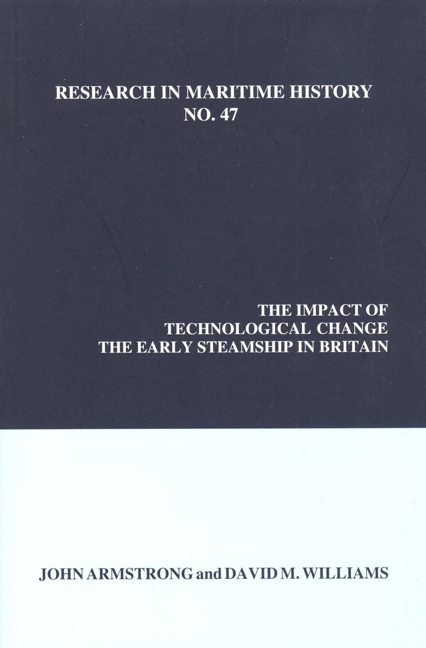Book contents
- Frontmatter
- Contents
- Series Editor's Foreword
- About the Authors
- Introduction
- Chapter 1 British Steam Navigation, 1812 to the 1850s: A Bibliographical and Historiographical Review
- Chapter 2 Some Official Listings of “Vessels Navigated by Steam” in Britain up to 1851: Evidence and Interpretation
- Chapter 3 The Steamboat, Safety and the State: Government Reaction to New Technology in a Period of Laissez-Faire
- Chapter 4 The Steamboat and Popular Tourism
- Chapter 5 The Thames and Recreation, 1815-1840
- Chapter 6 Steam Shipping and the Beginnings of Overseas Tourism: British Travel to North Western Europe, 1820-1850
- Chapter 7 Technological Advance and Innovation: The Diffusion of the Early Steamship in the United Kingdom, 1812-1834
- Chapter 8 The Steamship as an Agent of Modernisation, 1812-1840
- Chapter 9 “A New and Very Modern Business:” The Traffic and Operations of the Early Steamship
- Chapter 10 Promotion, Speculation and Their Outcome: The “Steamship Mania” of 1824-1825
- Chapter 11 The Perception and Understanding of New Technology: A Failed Attempt to Establish Transatlantic Steamship Liner Services, 1824-1828
- Chapter 12 The “Norwich Explosion” of 1817: A Local Tragedy of National Significance
- Chapter 13 Early Steamboat Services and Their Impact in North Wales, 1817-1840s
- Chapter 14 The Beginnings of a New Technology: The Constructors of Early Steamboats, 1812-1822
Chapter 11 - The Perception and Understanding of New Technology: A Failed Attempt to Establish Transatlantic Steamship Liner Services, 1824-1828
- Frontmatter
- Contents
- Series Editor's Foreword
- About the Authors
- Introduction
- Chapter 1 British Steam Navigation, 1812 to the 1850s: A Bibliographical and Historiographical Review
- Chapter 2 Some Official Listings of “Vessels Navigated by Steam” in Britain up to 1851: Evidence and Interpretation
- Chapter 3 The Steamboat, Safety and the State: Government Reaction to New Technology in a Period of Laissez-Faire
- Chapter 4 The Steamboat and Popular Tourism
- Chapter 5 The Thames and Recreation, 1815-1840
- Chapter 6 Steam Shipping and the Beginnings of Overseas Tourism: British Travel to North Western Europe, 1820-1850
- Chapter 7 Technological Advance and Innovation: The Diffusion of the Early Steamship in the United Kingdom, 1812-1834
- Chapter 8 The Steamship as an Agent of Modernisation, 1812-1840
- Chapter 9 “A New and Very Modern Business:” The Traffic and Operations of the Early Steamship
- Chapter 10 Promotion, Speculation and Their Outcome: The “Steamship Mania” of 1824-1825
- Chapter 11 The Perception and Understanding of New Technology: A Failed Attempt to Establish Transatlantic Steamship Liner Services, 1824-1828
- Chapter 12 The “Norwich Explosion” of 1817: A Local Tragedy of National Significance
- Chapter 13 Early Steamboat Services and Their Impact in North Wales, 1817-1840s
- Chapter 14 The Beginnings of a New Technology: The Constructors of Early Steamboats, 1812-1822
Summary
Communications between Europe and the Americas have been an essential element in the development of the Atlantic economy. In this context, the coming of steam in the nineteenth century was truly revolutionary in its impact. Not merely did steam bring greater speed; it also brought greater reliability and the regularization of commercial intercourse through scheduled liner services. These attributes were unobtainable under sail, and it was not until the late 1830s that steamships were sufficiently improved technologically to provide a measure of regular, transatlantic steam departures and arrivals. Long before this, however, the concept of liner services had been considered. Indeed, in 1819 an enterprise named the Ocean Steam Ship Company was incorporated in New York. Its organizers stated their aims as “desirous of constructing and employing steamships in navigating the oceans,” but nothing came of this project. In the same year came the much-publicized transatlantic crossing of Savannah. It was a dubious achievement for steam as the engine was used for only about thirteen percent of the whole voyage. More significant was a development in Britain in 1824, little more than a decade after the first commercial utilization of the steamship in Europe, the operation of Comet on the Clyde in 1812. The American and Colonial Steam Navigation Company (A&C), as the venture was entitled, proved unsuccessful, and perhaps this explains its neglect by some historians of transatlantic shipping. The A&C's history, however, merits consideration on a number of counts. Apart from its remarkably early timing, its imaginative ambition and its sad failure, the company is of interest in terms of what it reveals about the level of contemporary appreciation of technology. Living with and understanding technological progress are processes that are nowadays taken for granted; in the early stages of industrialization these were new experiences to be confronted. This paper reviews the thinking that lay behind the formation of the A&C, its unfortunate history and the insight it provides into the prevailing limited understanding of new technology and its operation.
- Type
- Chapter
- Information
- The Impact of Technological ChangeThe Early Steamship In Britain, pp. 225 - 244Publisher: Liverpool University PressPrint publication year: 2011



